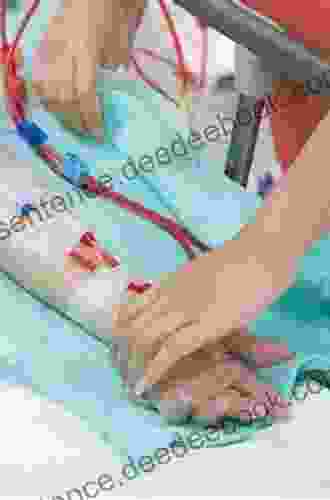Ensuring Adequate Vascular Access for Hemodialysis: A Comprehensive Guide

4.9 out of 5
| Language | : | English |
| File size | : | 11334 KB |
| Text-to-Speech | : | Enabled |
| Screen Reader | : | Supported |
| Enhanced typesetting | : | Enabled |
| Print length | : | 506 pages |
Hemodialysis is a life-sustaining treatment for patients with end-stage renal disease (ESRD). It involves using a machine to filter waste products and excess fluid from the blood. Adequate vascular access is essential for successful hemodialysis, as it allows for efficient blood flow to and from the dialysis machine.
Types of Vascular Access
There are three main types of vascular access for hemodialysis:
- Arteriovenous Fistula (AVF): An AVF is created by surgically connecting an artery to a vein in the arm. AVFs are the preferred type of vascular access because they have a lower risk of infection and thrombosis (blood clots).
- Arteriovenous Graft (AVG): An AVG is created by surgically connecting an artery to a vein using a synthetic graft. AVGs are used when an AVF cannot be created or maintained.
- Central Venous Catheter (CVC): A CVC is a temporary vascular access placed in a large vein in the neck, chest, or groin. CVCs are used when immediate dialysis is needed or when other types of vascular access cannot be created or maintained.
Creation of Vascular Access
The creation of vascular access is a surgical procedure performed by a vascular surgeon. The type of vascular access created depends on the patient's individual needs and anatomy.
- AVF Creation: An AVF is typically created in the forearm or upper arm. The surgeon makes a small incision and connects an artery to a vein using sutures.
- AVG Creation: An AVG is created using a synthetic graft. The surgeon makes an incision and connects the graft to an artery and a vein.
- CVC Placement: A CVC is placed by inserting a catheter into a large vein. The catheter is then secured in place with sutures.
Maintenance of Vascular Access
Proper maintenance of vascular access is essential to prevent complications and ensure successful hemodialysis.
- AVF Maintenance: AVFs require regular monitoring and care to keep them open and functioning properly. Patients should avoid putting pressure on the AVF and should keep it clean and free of infection.
- AVG Maintenance: AVGs also require regular monitoring and care. Patients should avoid putting pressure on the AVG and should keep it clean and free of infection. AVGs may also need to be repaired or replaced if they become damaged or blocked.
- CVC Maintenance: CVCs require special care to prevent infection. Patients should keep the CVC site clean and dry, and should avoid touching or manipulating the catheter.
Complications of Vascular Access
Vascular access complications can occur with any type of access.
- Infection: Infection is the most common complication of vascular access. It can occur at the site of the access or in the bloodstream.
- Thrombosis: Thrombosis is the formation of a blood clot in the vascular access. It can block blood flow and lead to serious complications.
- Bleeding: Bleeding can occur at the site of the vascular access. It is usually minor, but can be serious in some cases.
- Aneurysm: An aneurysm is a bulge in the wall of the blood vessel. It can occur at the site of the vascular access or in other parts of the body.
Monitoring of Vascular Access
Regular monitoring of vascular access is essential to detect and prevent complications.
- Physical Examination: The doctor or nurse will perform a physical examination of the vascular access to check for signs of infection, thrombosis, or other problems.
- Blood Tests: Blood tests can be used to check for signs of infection or other problems.
- Imaging Tests: Imaging tests, such as ultrasound, can be used to check the blood flow through the vascular access and to look for signs of thrombosis or other problems.
Adequate vascular access is essential for successful hemodialysis. There are three main types of vascular access: AVFs, AVGs, and CVCs. The type of access created depends on the patient's individual needs and anatomy. Proper maintenance of vascular access is essential to prevent complications and ensure successful hemodialysis. Regular monitoring of vascular access is also important to detect and prevent complications. By following these guidelines, patients can help to ensure that their hemodialysis treatment is as successful as possible.
4.9 out of 5
| Language | : | English |
| File size | : | 11334 KB |
| Text-to-Speech | : | Enabled |
| Screen Reader | : | Supported |
| Enhanced typesetting | : | Enabled |
| Print length | : | 506 pages |
Do you want to contribute by writing guest posts on this blog?
Please contact us and send us a resume of previous articles that you have written.
 Chapter
Chapter Text
Text Story
Story Genre
Genre Reader
Reader Library
Library E-book
E-book Sentence
Sentence Bookmark
Bookmark Shelf
Shelf Bibliography
Bibliography Foreword
Foreword Synopsis
Synopsis Footnote
Footnote Scroll
Scroll Bestseller
Bestseller Narrative
Narrative Dictionary
Dictionary Narrator
Narrator Character
Character Resolution
Resolution Catalog
Catalog Card Catalog
Card Catalog Borrowing
Borrowing Stacks
Stacks Archives
Archives Periodicals
Periodicals Research
Research Reserve
Reserve Academic
Academic Reading Room
Reading Room Rare Books
Rare Books Interlibrary
Interlibrary Literacy
Literacy Study Group
Study Group Thesis
Thesis Storytelling
Storytelling Awards
Awards Book Club
Book Club Theory
Theory Claire Contreras
Claire Contreras Mike Laughead
Mike Laughead Jean Hanff Korelitz
Jean Hanff Korelitz Chuck Hornung
Chuck Hornung Robert G Lee
Robert G Lee Raisa Maria Toivo
Raisa Maria Toivo Tad Richards
Tad Richards Krys Maki
Krys Maki Wounded Warrior Publications
Wounded Warrior Publications Orlando Crespo
Orlando Crespo June Jordan
June Jordan Lorelei Eurto
Lorelei Eurto Warren Magnusson
Warren Magnusson Ziauddin Sardar
Ziauddin Sardar Bill Bradley
Bill Bradley Gerard Noel
Gerard Noel Helen Perelman
Helen Perelman Nancy Beck Young
Nancy Beck Young B S Levy
B S Levy Karen Solomon
Karen Solomon
Light bulbAdvertise smarter! Our strategic ad space ensures maximum exposure. Reserve your spot today!

 Ryūnosuke AkutagawaAmerica's Deadliest Publicity Stunt Disaster: The Crash of the Knickerbocker...
Ryūnosuke AkutagawaAmerica's Deadliest Publicity Stunt Disaster: The Crash of the Knickerbocker... Lawrence BellFollow ·6.3k
Lawrence BellFollow ·6.3k John MiltonFollow ·11.6k
John MiltonFollow ·11.6k Craig BlairFollow ·5.1k
Craig BlairFollow ·5.1k Francisco CoxFollow ·13k
Francisco CoxFollow ·13k Clark CampbellFollow ·4.7k
Clark CampbellFollow ·4.7k Maurice ParkerFollow ·14.2k
Maurice ParkerFollow ·14.2k Giovanni MitchellFollow ·5.5k
Giovanni MitchellFollow ·5.5k Bryson HayesFollow ·16.8k
Bryson HayesFollow ·16.8k

 Darren Nelson
Darren NelsonLife of Napoleon Bonaparte, Volume II: His Rise to Power
**** Napoleon...

 Reed Mitchell
Reed MitchellLucy Sullivan Is Getting Married: A Tale of Love,...
Lucy Sullivan is a...

 Chuck Mitchell
Chuck MitchellBeginner's Crash Course on Python Language: Getting...
Python is a widely used programming...

 Henry Hayes
Henry HayesThreads Fitting For Every Figure: A Comprehensive Guide...
Finding the perfect fit can be a...

 Duane Kelly
Duane KellyA Comprehensive Cat Guide to Money: Feline Finance for...
In the world of finance, humans have...

 Jedidiah Hayes
Jedidiah HayesThe Sentimental Hippo And His Friends
Harvey the hippo was a very sentimental...
4.9 out of 5
| Language | : | English |
| File size | : | 11334 KB |
| Text-to-Speech | : | Enabled |
| Screen Reader | : | Supported |
| Enhanced typesetting | : | Enabled |
| Print length | : | 506 pages |










